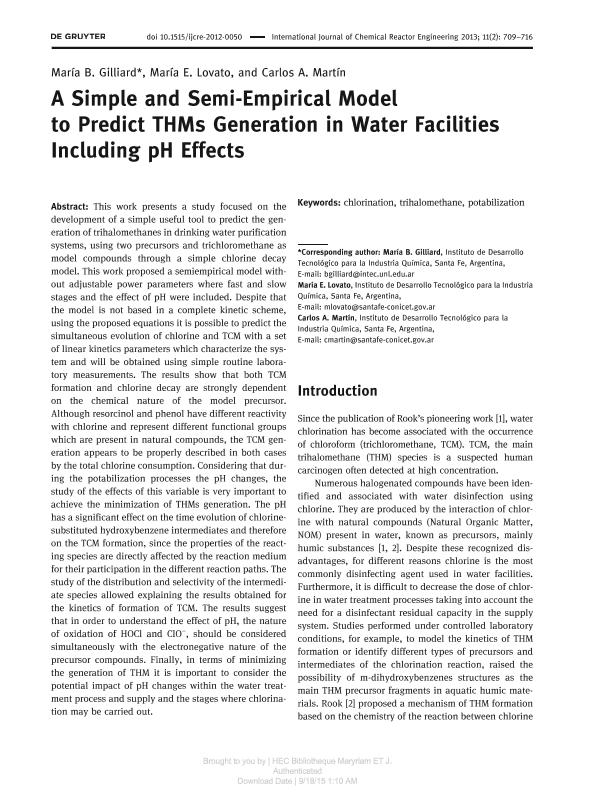Mostrar el registro sencillo del ítem
dc.contributor.author
Gilliard, María Belén

dc.contributor.author
Lovato, Maria Eugenia

dc.contributor.author
Martía, Carlos A.
dc.date.available
2016-01-07T17:01:01Z
dc.date.issued
2013-06-20
dc.identifier.citation
Gilliard, María Belén; Lovato, Maria Eugenia; Martía, Carlos A.; A simple and semi-empirical model to predict THMs generation in water facilities including pH effects; De Gruyter; International Journal of Chemical Reactor Engineering; 11; 2; 20-6-2013; 709–716
dc.identifier.issn
1542-6580
dc.identifier.uri
http://hdl.handle.net/11336/3409
dc.description.abstract
This work presents a study focused on the development of a simple useful tool to predict the generation of trihalomethanes in drinking water purification systems, using two precursors and trichloromethane as model compounds through a simple chlorine decay model. This work proposed a semiempirical model without adjustable power parameters where fast and slow stages and the effect of pH were included. Despite that the model is not based in a complete kinetic scheme, using the proposed equations it is possible to predict the simultaneous evolution of chlorine and TCM with a set of linear kinetics parameters which characterize the system and will be obtained using simple routine laboratory measurements. The results show that both TCM formation and chlorine decay are strongly dependent on the chemical nature of the model precursor. Although resorcinol and phenol have different reactivity with chlorine and represent different functional groups which are present in natural compounds, the TCM generation appears to be properly described in both cases by the total chlorine consumption. Considering that during the potabilization processes the pH changes, the study of the effects of this variable is very important to achieve the minimization of THMs generation. The pH has a significant effect on the time evolution of chlorine-substituted hydroxybenzene intermediates and therefore on the TCM formation, since the properties of the reacting species are directly affected by the reaction medium for their participation in the different reaction paths. The study of the distribution and selectivity of the intermediate species allowed explaining the results obtained for the kinetics of formation of TCM. The results suggest that in order to understand the effect of pH, the nature of oxidation of HOCl and ClO‒, should be considered simultaneously with the electronegative nature of the precursor compounds. Finally, in terms of minimizing the generation of THM it is important to consider the potential impact of pH changes within the water treatment process and supply and the stages where chlorination may be carried out
dc.format
application/pdf
dc.language.iso
eng
dc.publisher
De Gruyter

dc.rights
info:eu-repo/semantics/openAccess
dc.rights.uri
https://creativecommons.org/licenses/by-nc-sa/2.5/ar/
dc.subject
Chloroform
dc.subject
Water
dc.subject
Thms
dc.subject
Kinetic
dc.subject.classification
Ingeniería Medioambiental y Geológica, Geotécnicas

dc.subject.classification
Ingeniería del Medio Ambiente

dc.subject.classification
INGENIERÍAS Y TECNOLOGÍAS

dc.title
A simple and semi-empirical model to predict THMs generation in water facilities including pH effects
dc.type
info:eu-repo/semantics/article
dc.type
info:ar-repo/semantics/artículo
dc.type
info:eu-repo/semantics/publishedVersion
dc.date.updated
2016-03-30 10:35:44.97925-03
dc.journal.volume
11
dc.journal.number
2
dc.journal.pagination
709–716
dc.journal.pais
Alemania

dc.journal.ciudad
Berlín
dc.description.fil
Fil: Gilliard, María Belén. Consejo Nacional de Investigaciones Científicas y Técnicas. Centro Científico Tecnológico Santa Fe. Instituto de Investigaciones en Catálisis y Petroquímica; Argentina. Consejo Nacional de Investigaciones Científicas y Técnicas. Centro Científico Tecnológico Santa Fe. Instituto de Desarrollo Tecnológico para la Industria Química (i); Argentina
dc.description.fil
Fil: Lovato, Maria Eugenia. Consejo Nacional de Investigaciones Científicas y Técnicas. Centro Científico Tecnológico Santa Fe. Instituto de Desarrollo Tecnológico para la Industria Química (i); Argentina
dc.description.fil
Fil: Martía, Carlos A.. Consejo Nacional de Investigaciones Científicas y Técnicas. Centro Científico Tecnológico Santa Fe. Instituto de Desarrollo Tecnológico para la Industria Química (i); Argentina
dc.journal.title
International Journal of Chemical Reactor Engineering

dc.relation.alternativeid
info:eu-repo/semantics/altIdentifier/url/http://www.degruyter.com/view/j/ijcre.2013.11.issue-2/ijcre-2012-0050/ijcre-2012-0050.xml
dc.relation.alternativeid
info:eu-repo/semantics/altIdentifier/doi/http://dx.doi.org/10.1515/ijcre-2012-0050
Archivos asociados
